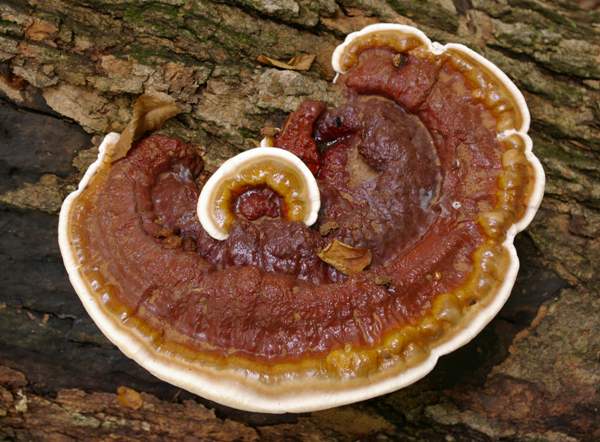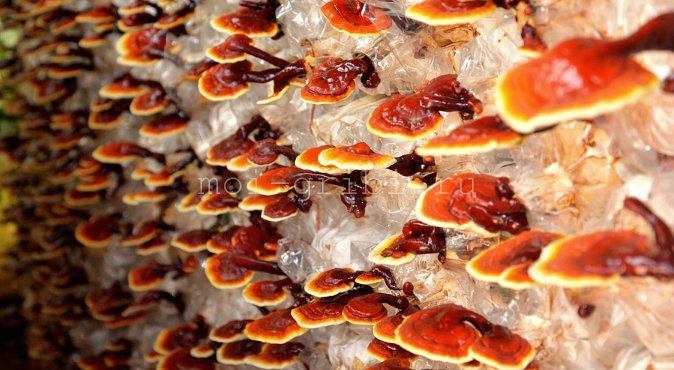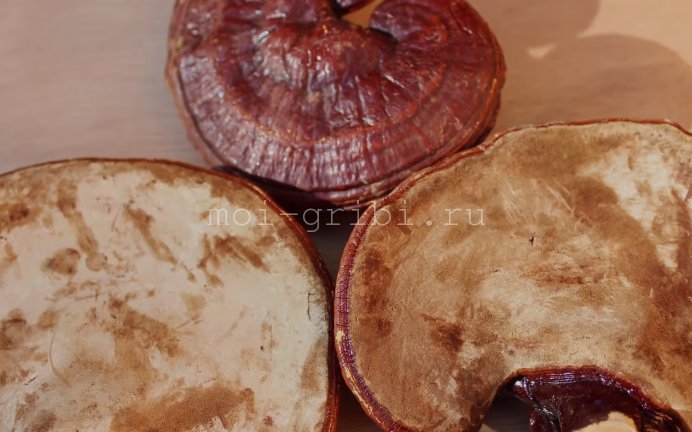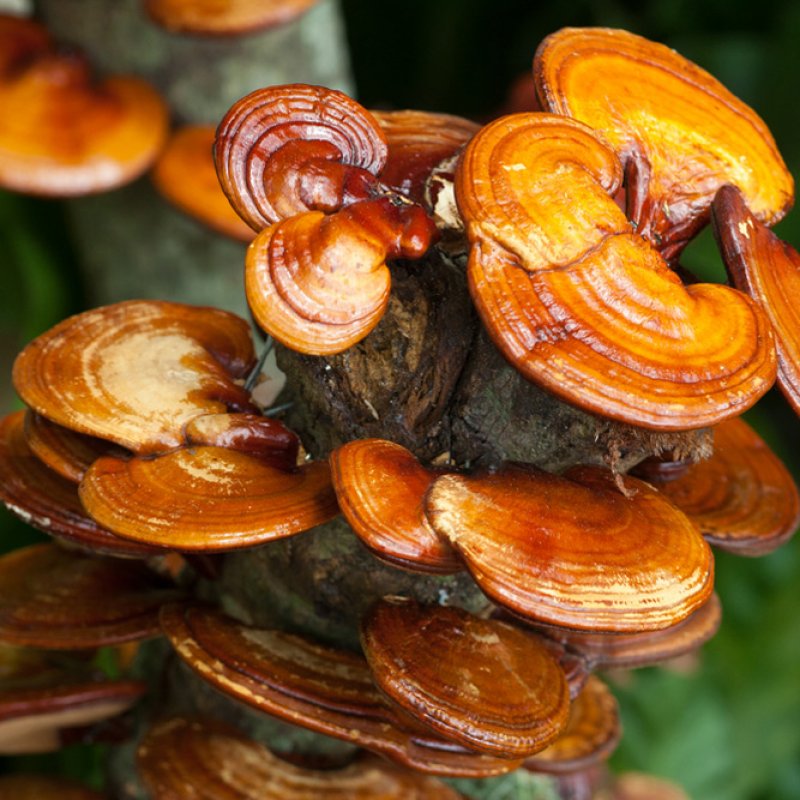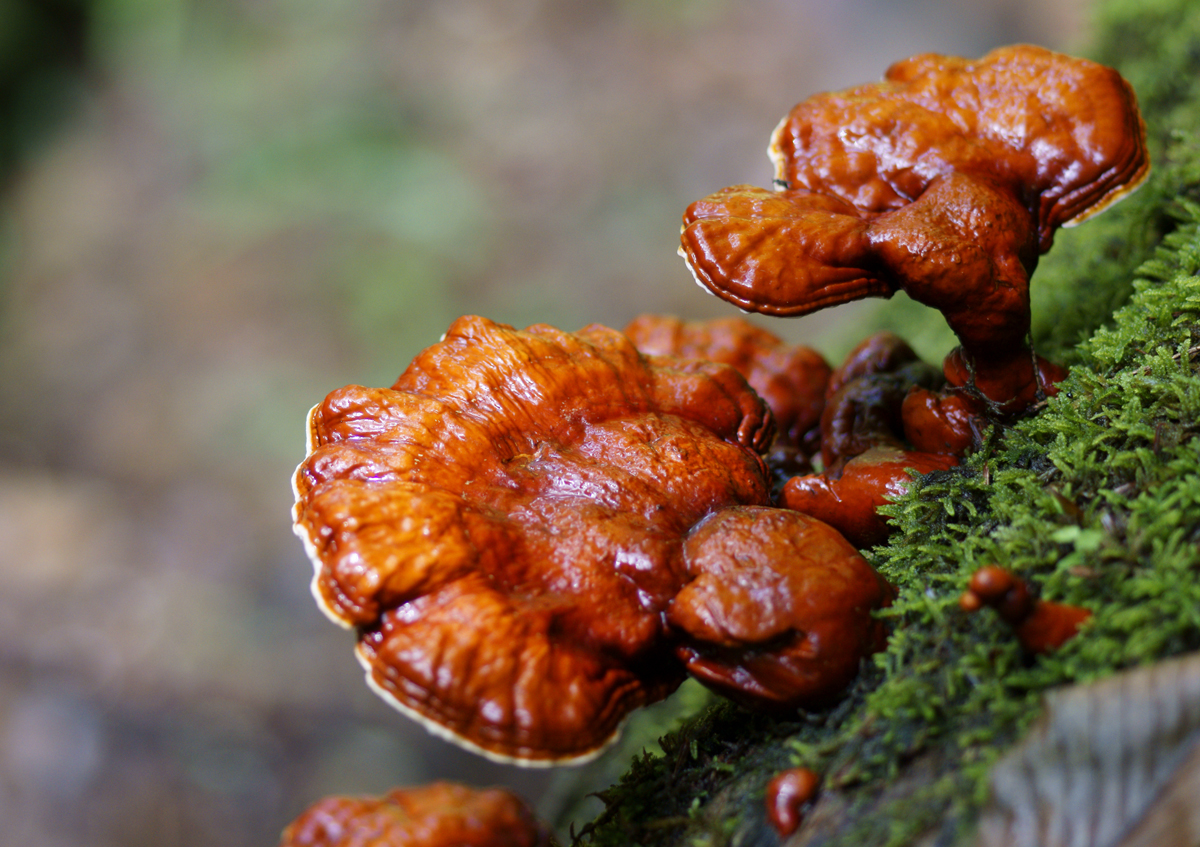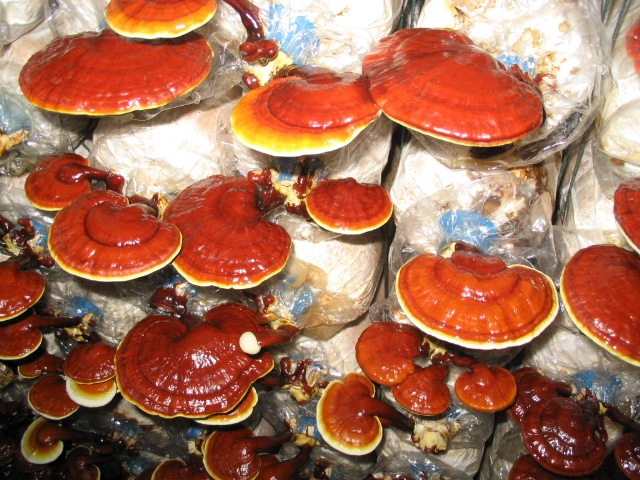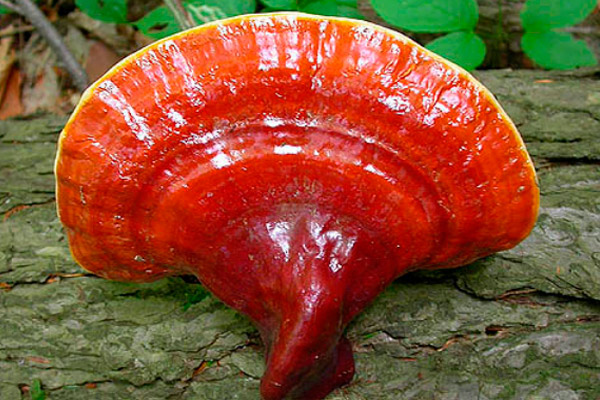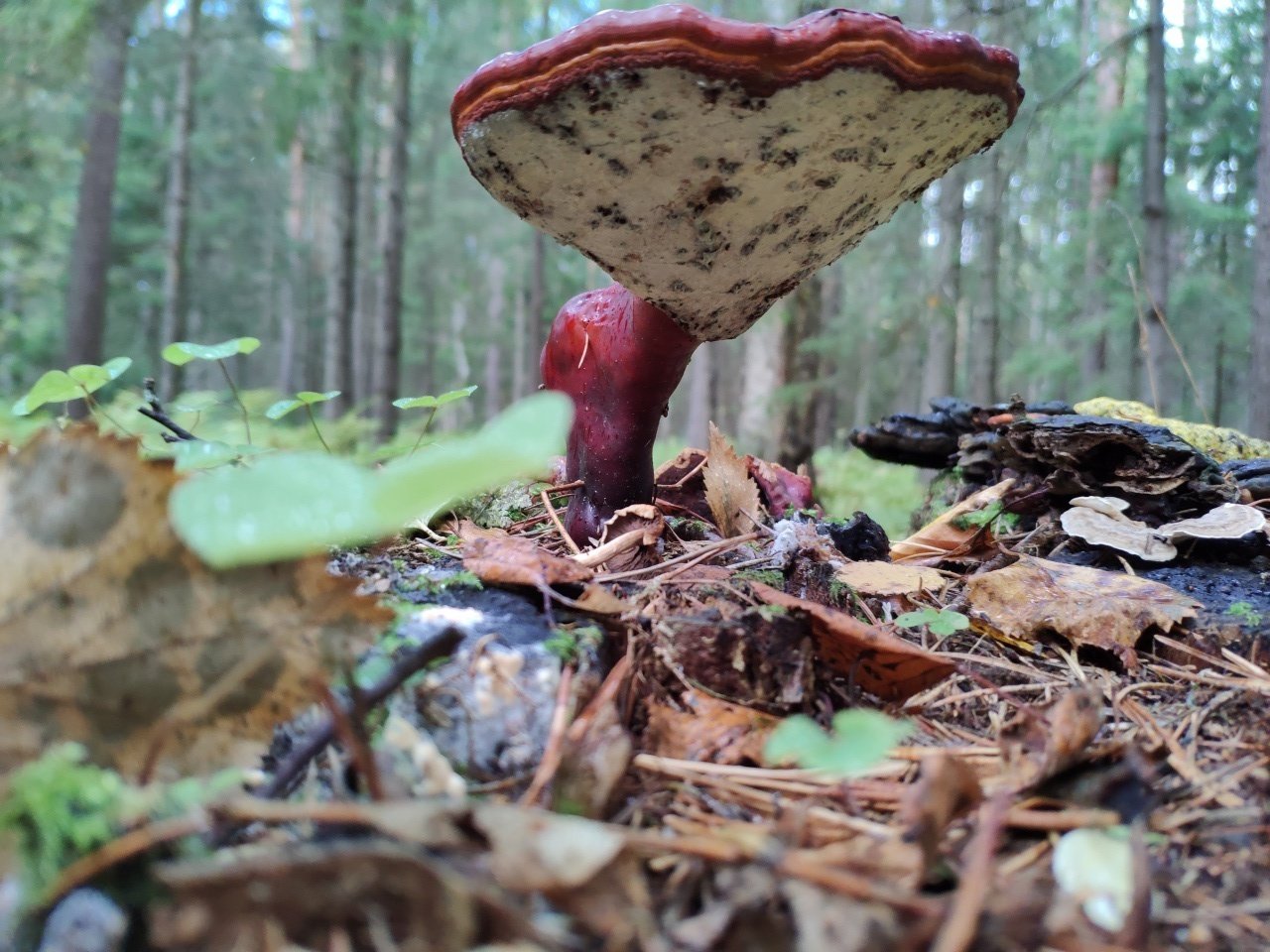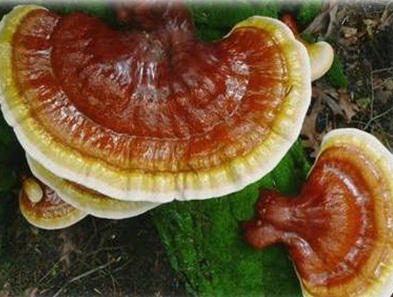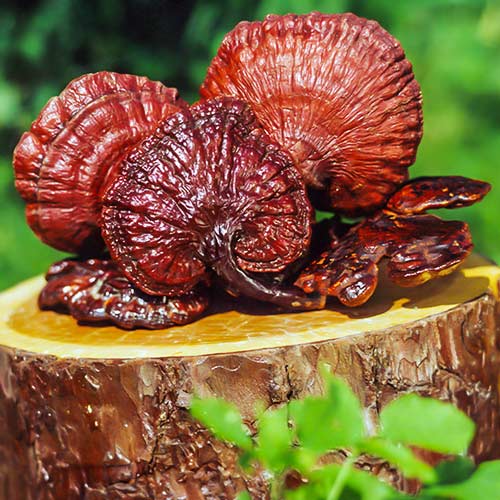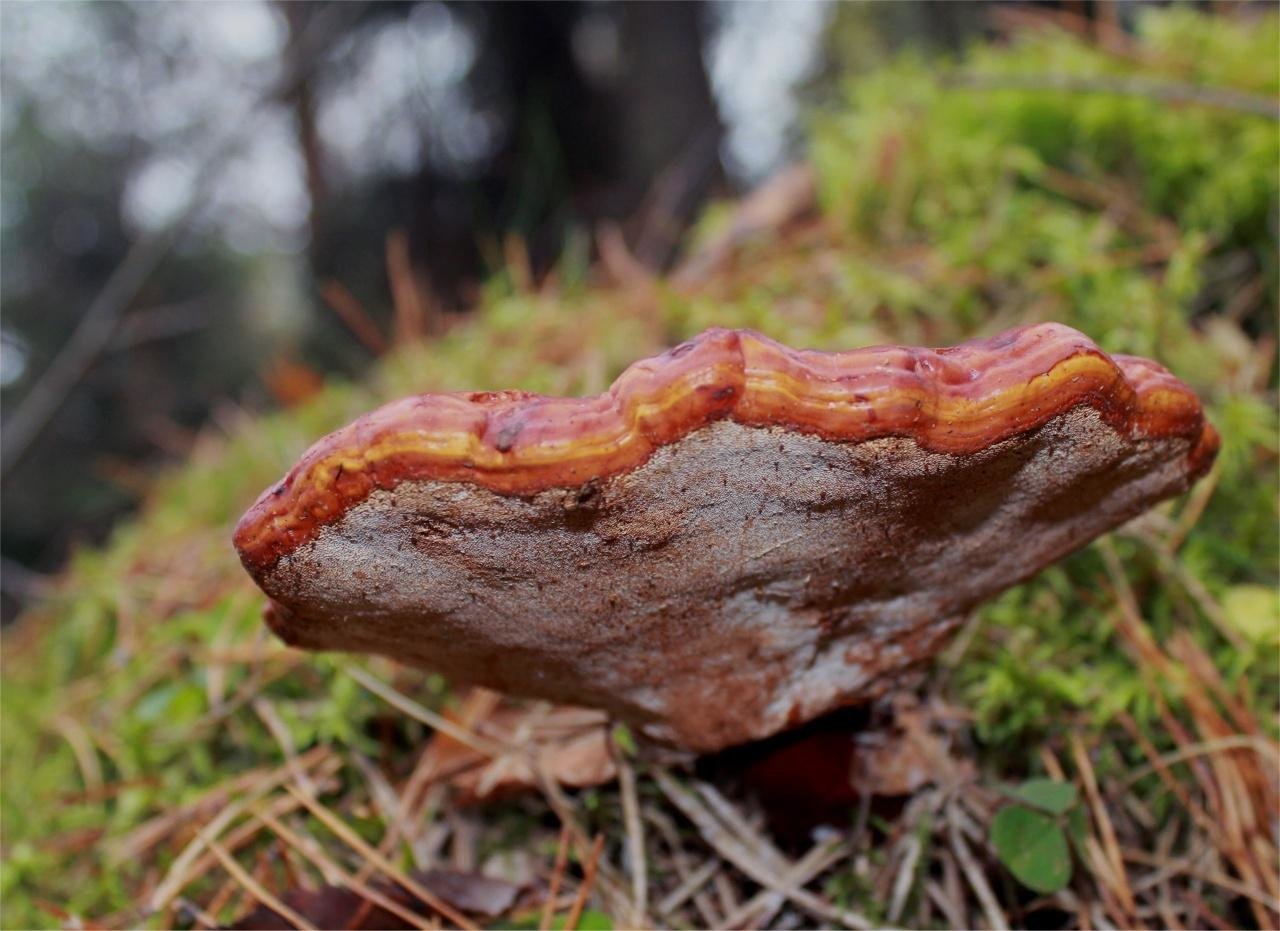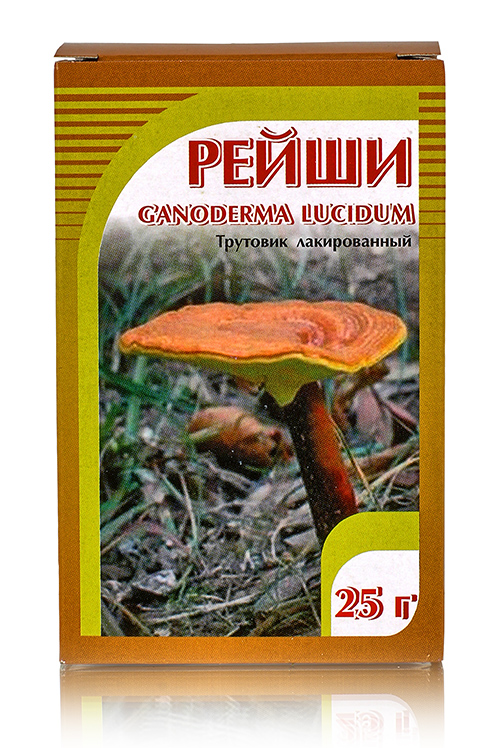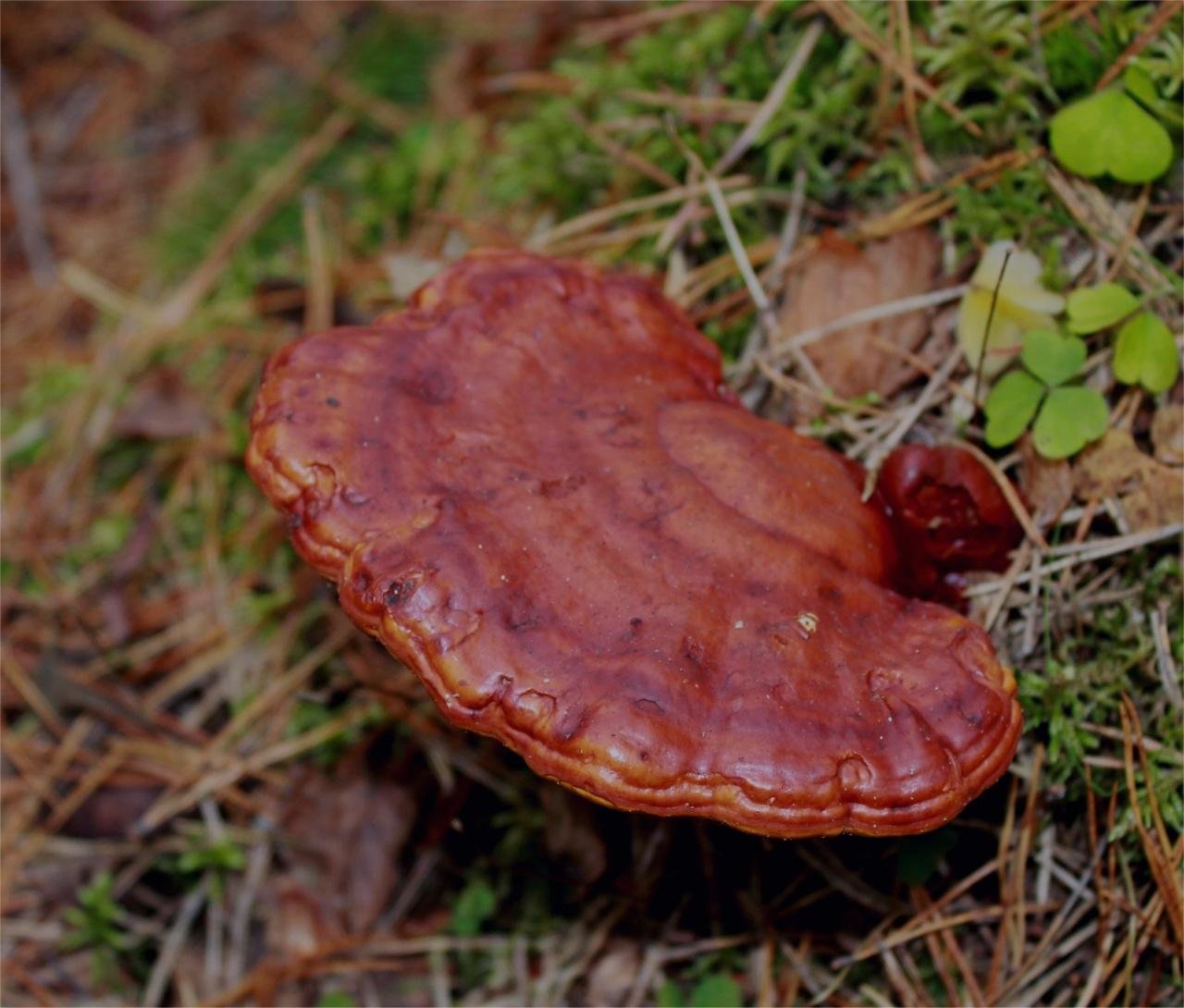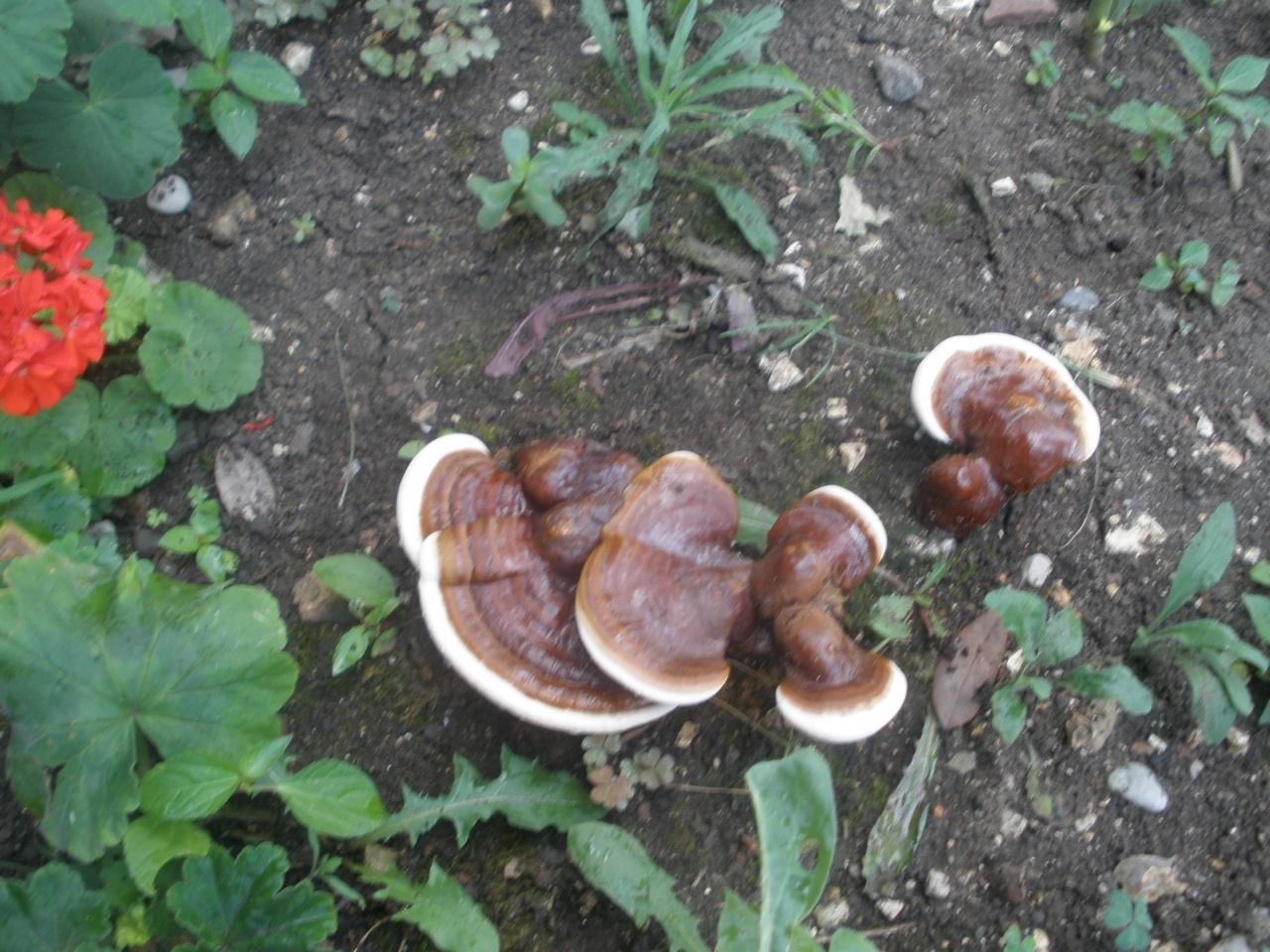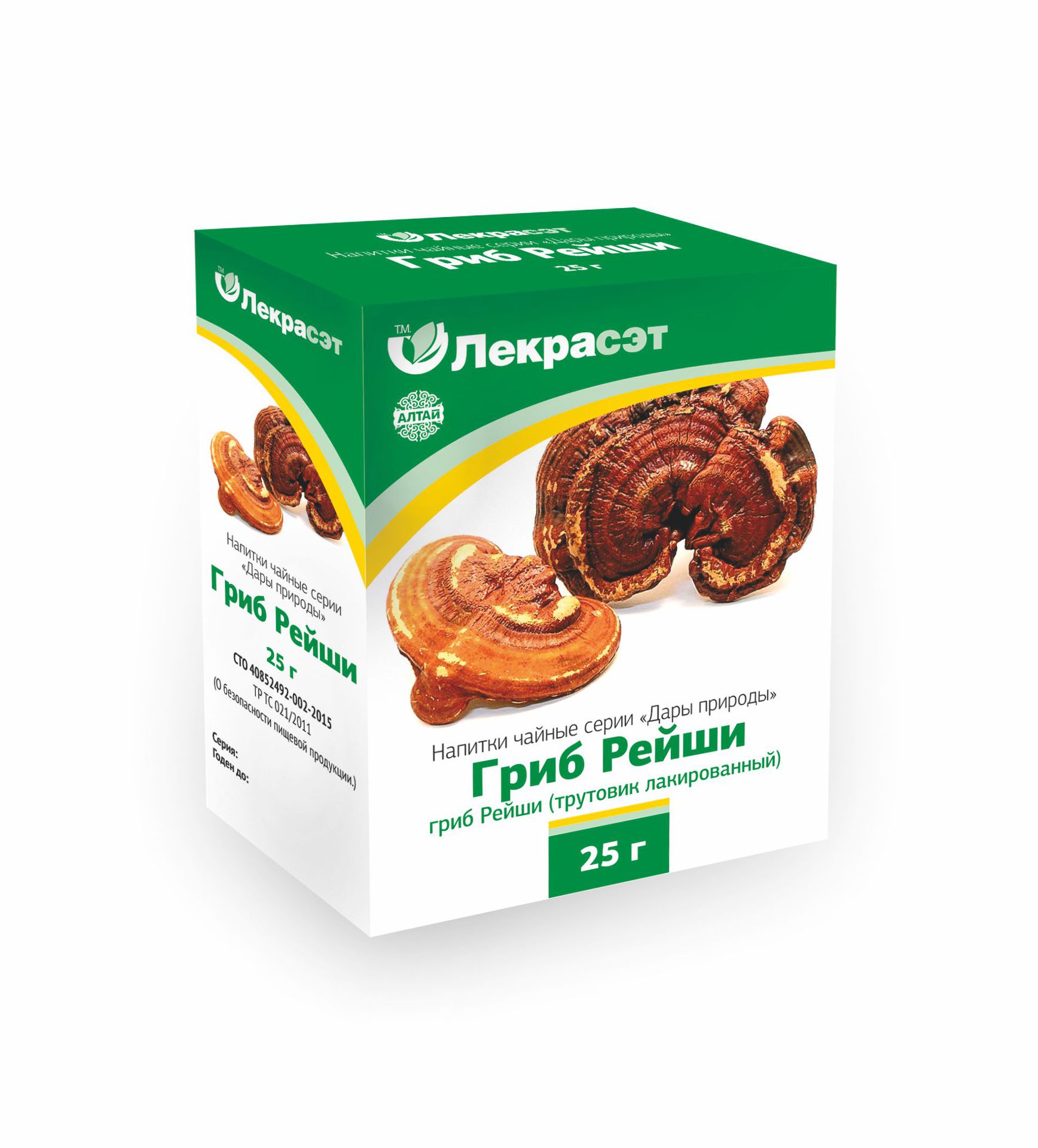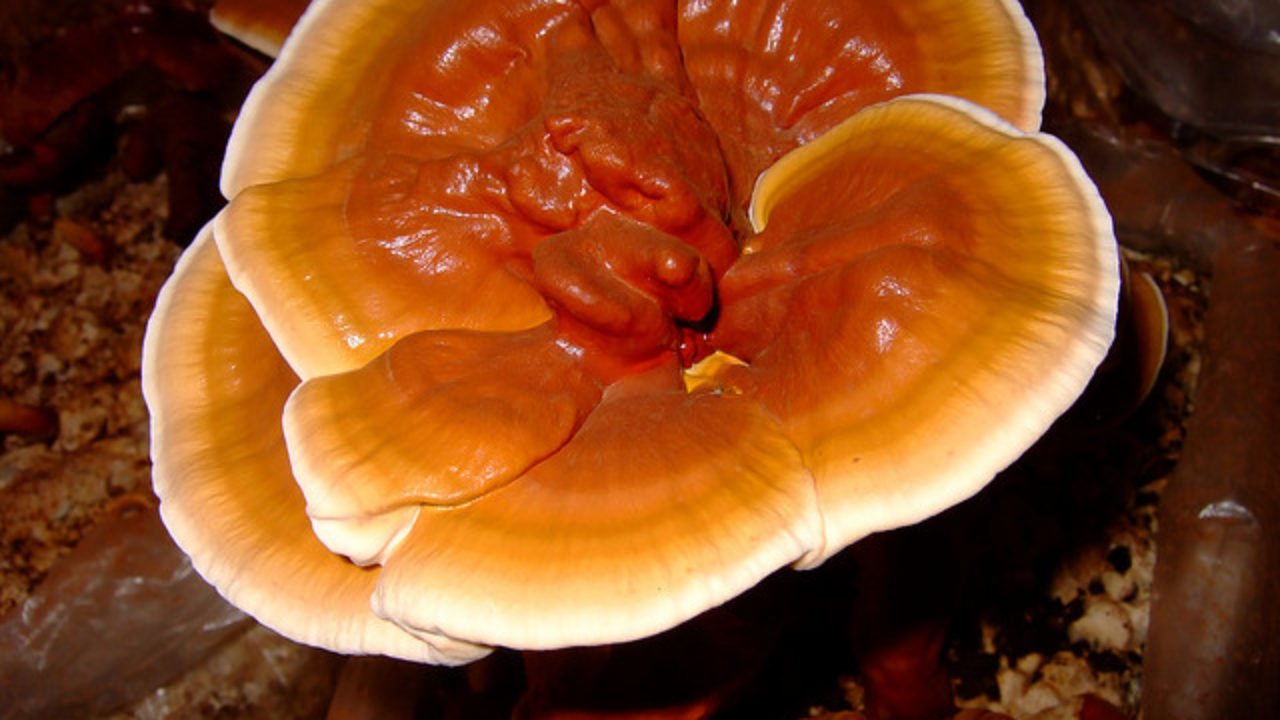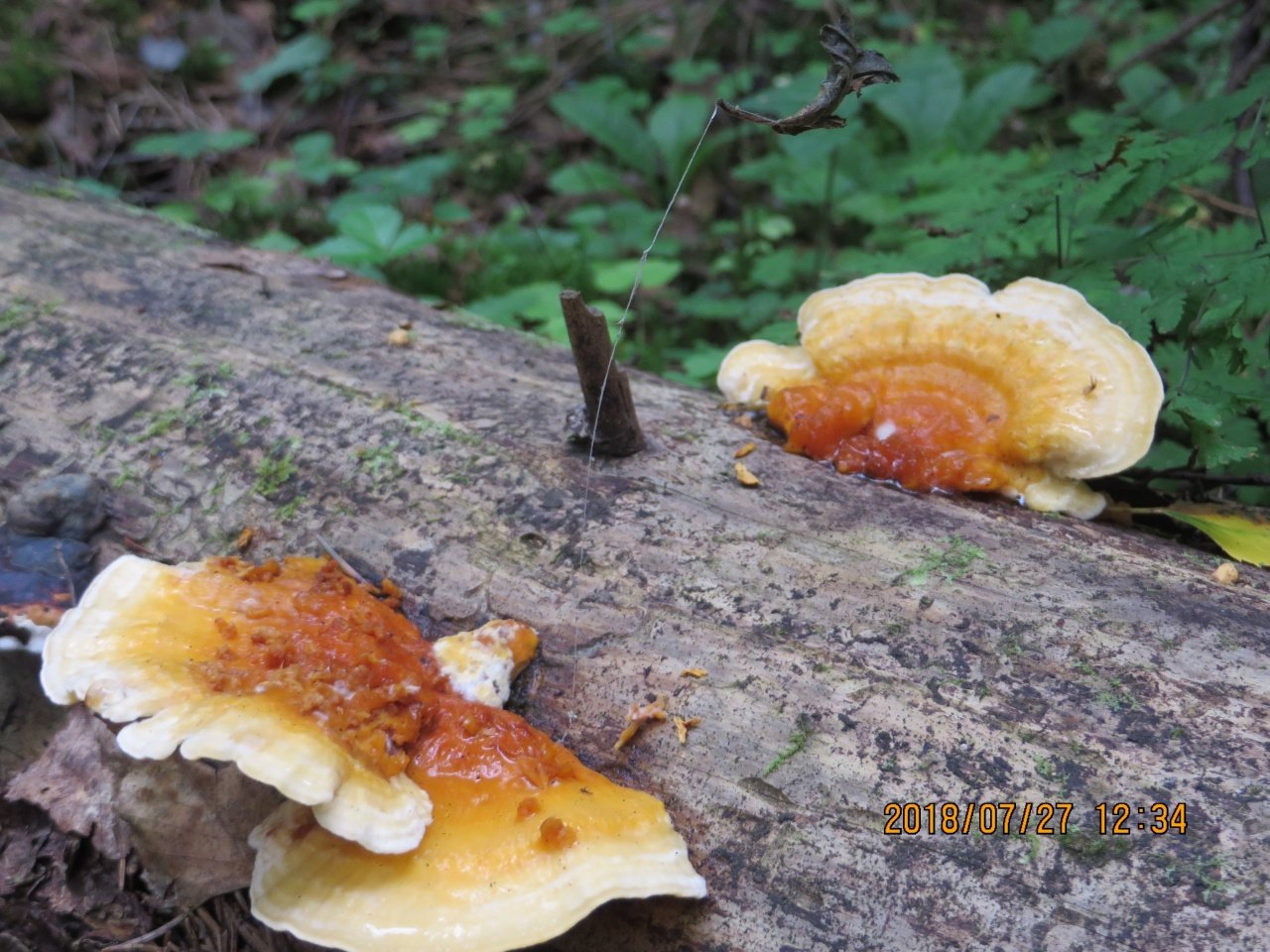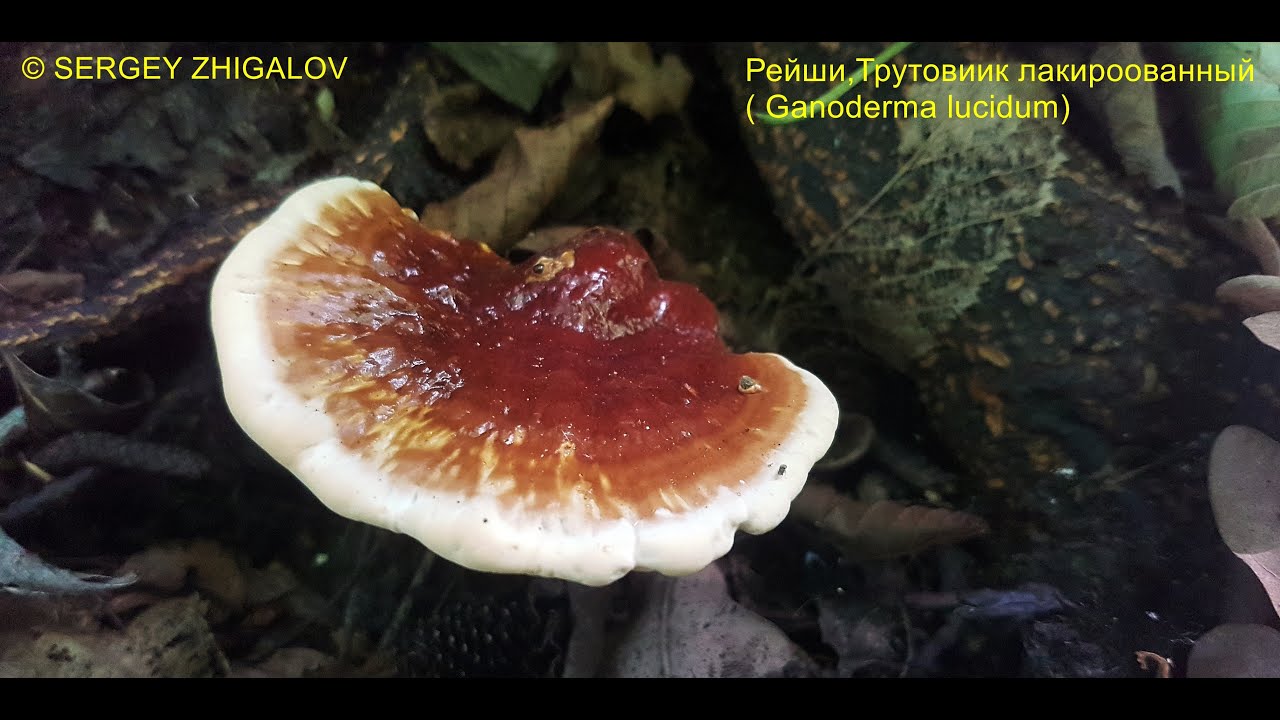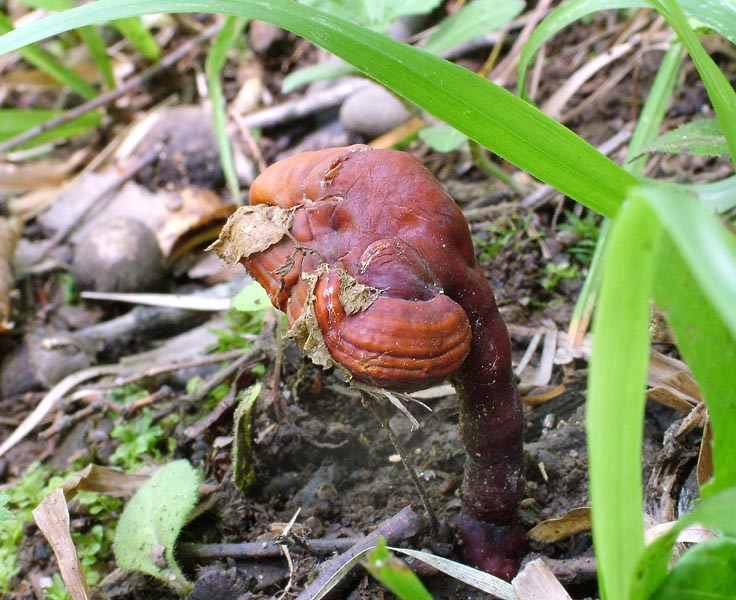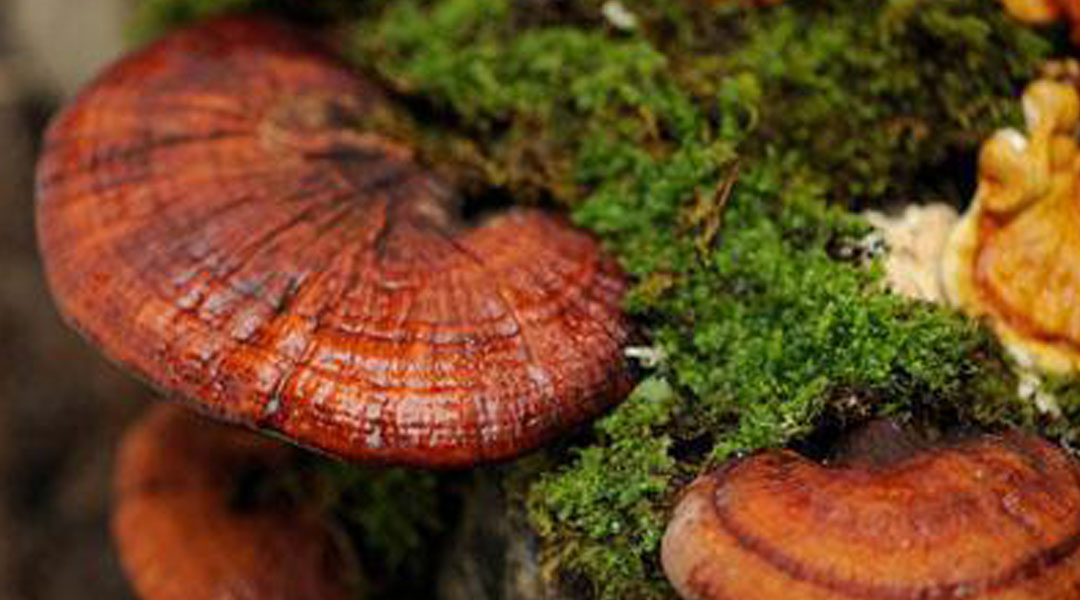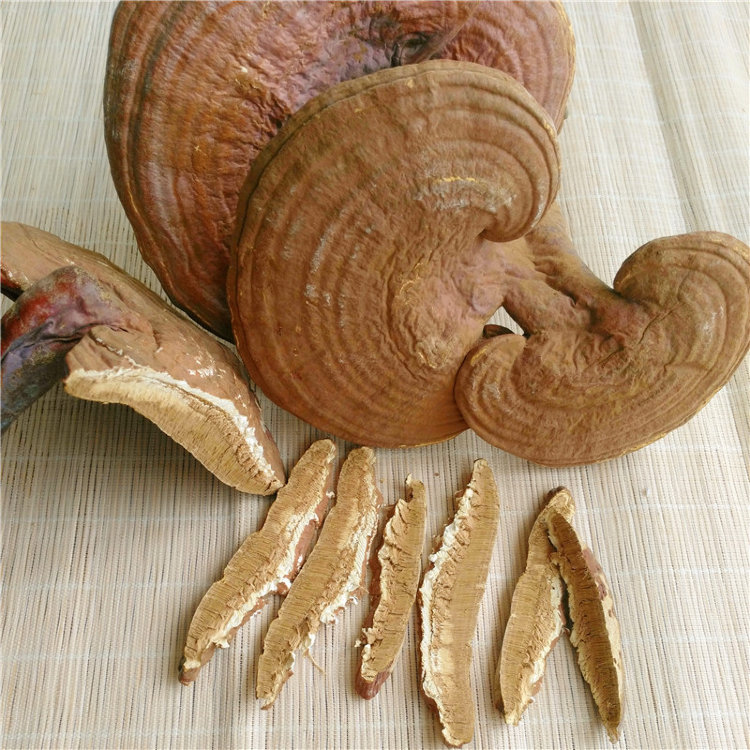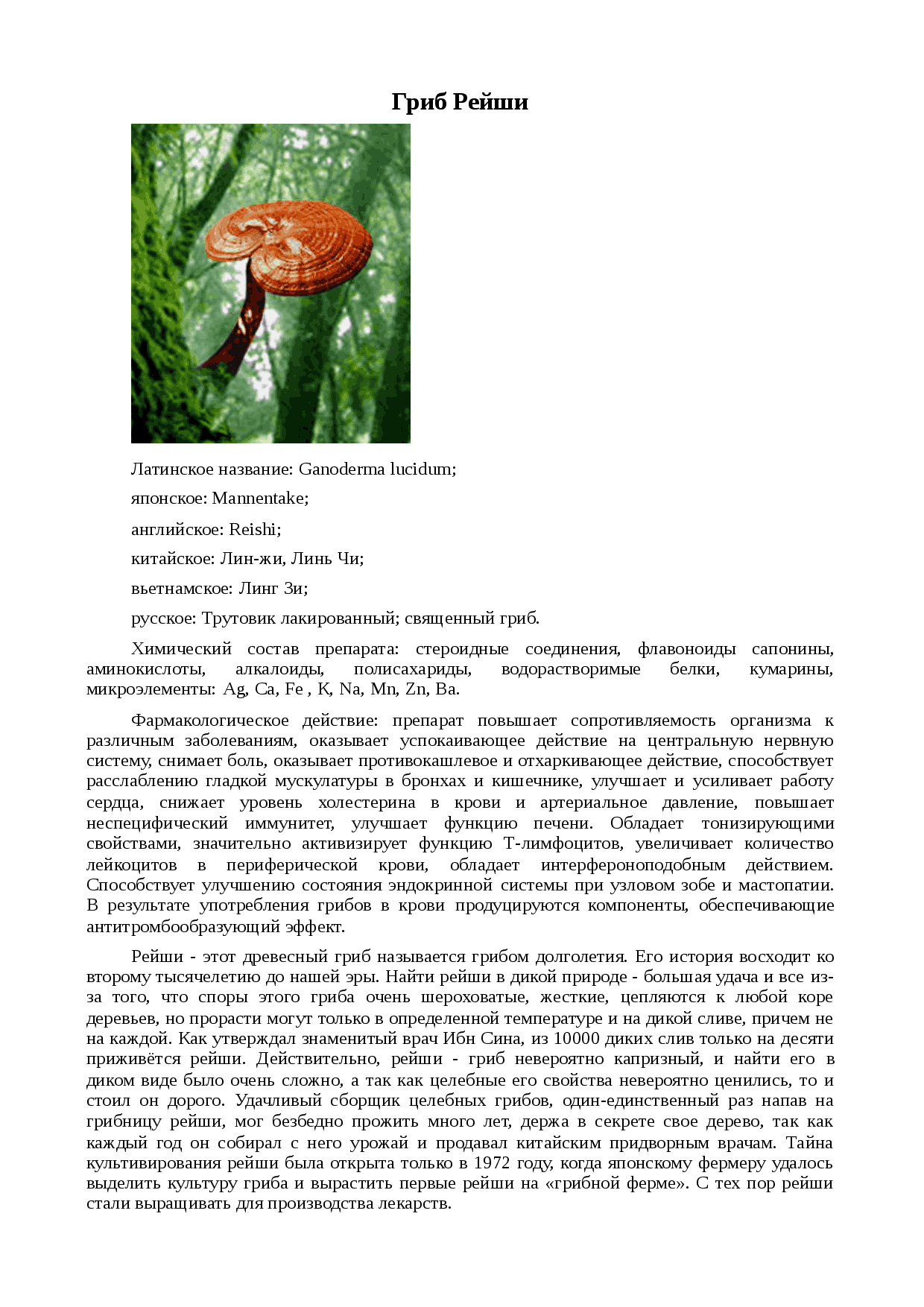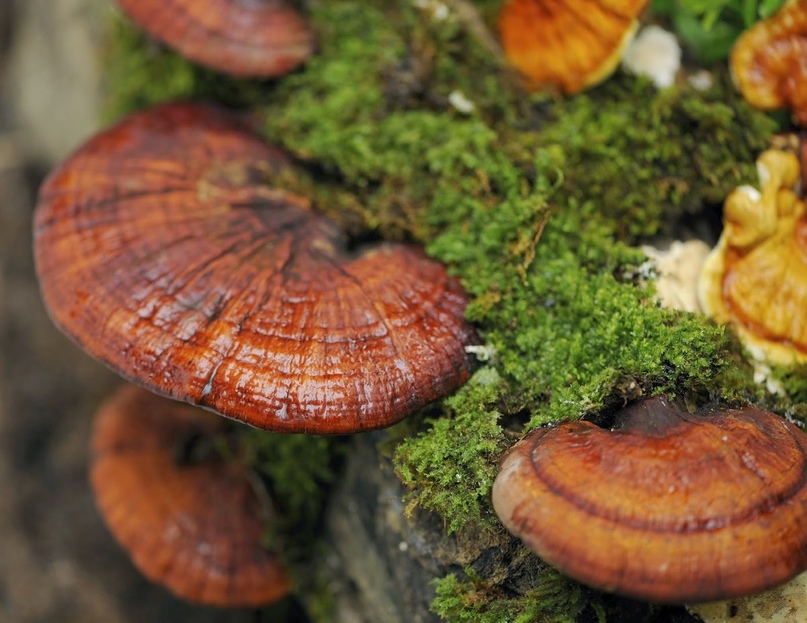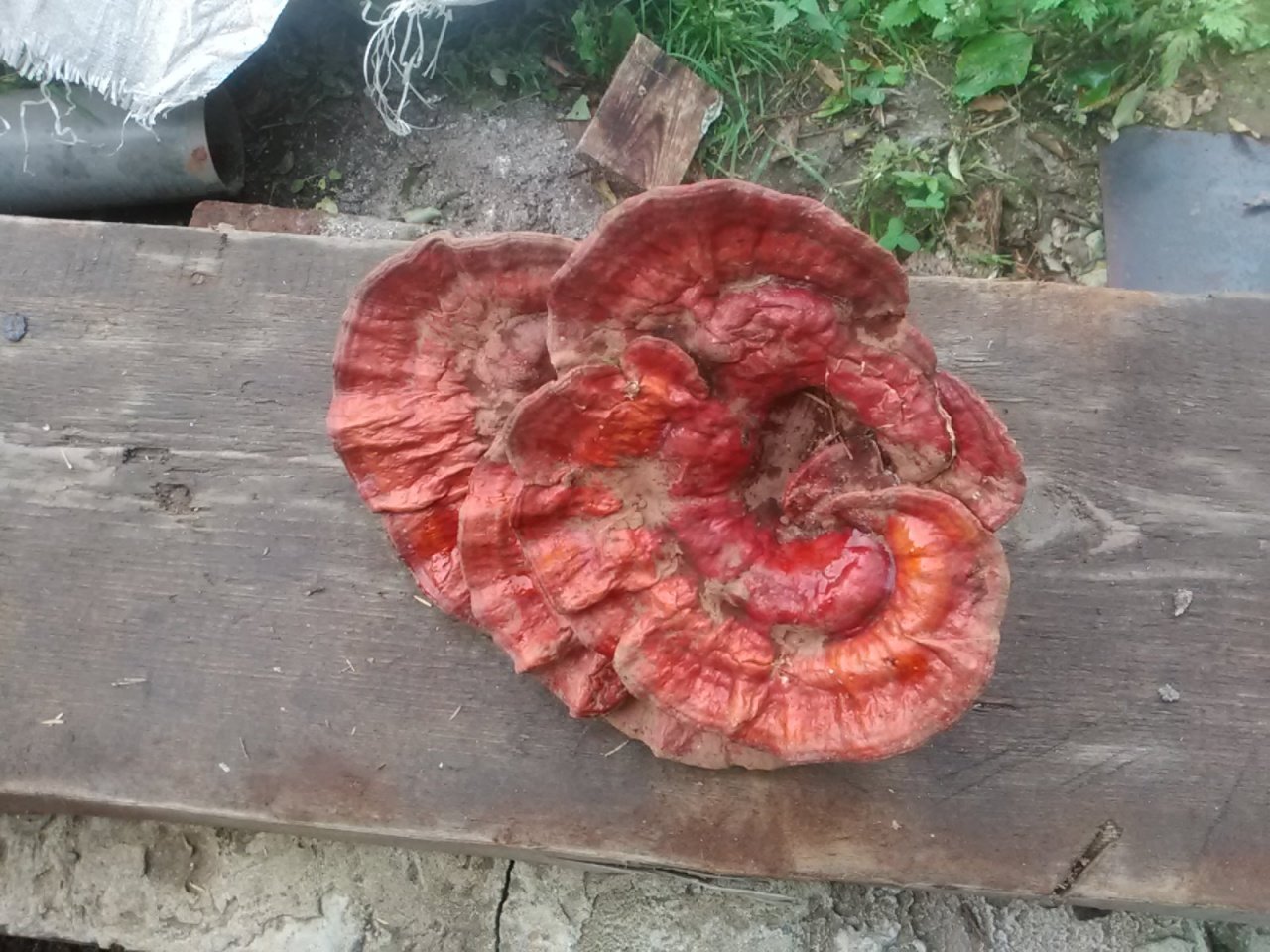Interesting Facts
It is very difficult to find lingzhi in nature. In ancient times, the place where the mushroom grew was kept in great secret. Only a select few possessed this knowledge, they passed data from generation to generation.
According to the entries in Shen Nong Ben Cao Jing, Reishi has 6 varieties associated with the elements:
- The Green Dragon Mushroom from the sacred Mount Taishan has a sour taste and heals the liver (wood);
- Yellow from Songshan Mountain - sweet in taste and heals the spleen (earth);
- Red from Hengshan Mountain - bitter, medicine for the heart (fire);
- Black from Changshan Mountain - salty and heals kidneys (water);
- White jasper mushroom from Huashan Mountain - pungent and heals the lungs (metal);
- Woody gives eternal youth to the body, is most often found in nature, is neutral in taste.
Lacquered tinder fungus spores are one of the most valuable parts of the fungus. However, all of them are covered with a dense black shell, the removal of which requires the use of high technologies.
A large number of people who want to improve their health with the help of the miracle mushroom has led to the fact that many companies have appeared around the world that produce counterfeit medicines based on Reishi. When buying, you should definitely check the quality certificate and do not trust dubious sellers. In addition, it must be remembered that acquiring a genuine lingzhi is not a cheap pleasure.
The growth of lingzhi has always been accompanied by dozens of legends and mystical stories, most of which mentioned Taoists. According to legend, the real mushroom was guarded by dragons and snakes.
Triterpenoids, which are part of ganoderma gum, have a similar effect to hormonal steroids, allowing the body to quickly recover and increase working capacity. But, unlike steroids, mushrooms do not have a detrimental effect on the liver and kidneys. That is why lingzhi-based drugs are so popular among athletes.
The unique healing properties of Reishi can be enumerated indefinitely. Western medicine is just beginning to fully investigate this amazing gift of nature, while Chinese pharmacists have been creating entire courses of treatment based on lingzhi for a very long time. In any case, you should be very careful about experimenting with your health and take any medications only after consulting your doctor.
Description of lacquered tinder fungus
The diameter of the lacquered tinder fungus cap is on average 8-20 centimeters. The shape of the cap is ovoid; its structure is very strong, woody. The hat is covered with a shiny, smooth skin. It is wavy, uneven, divided into numerous concentric rings of different shades. The color of the cap varies from reddish to violet-brown, sometimes it can be black with a yellowish tinge, while the growth rings stand out well.

The height of the leg of the Reishi mushroom ranges from 5 to 25 centimeters, and its diameter is 1-3 centimeters. The leg is long, cylindrical, uneven, growing laterally. The leg is very dense in structure. The tubes are short ocher in color.
The pulp of lacquered tinder fungus is very tough, ocher color. The pulp has no taste or smell. At first, the structure of the pulp is spongy, but over time it stiffens. The pores are round and small, at first they are whitish, but then they turn yellow and brown. Spore powder, brown color.
Spread of lacquered tinder fungus
Lacquered polypores grow in almost all countries of the world. These are saprophytic mushrooms - wood destroyers, as a result of which white rot is formed on trees. They settle on weakened or dying deciduous trees, very rarely found on conifers.Occasionally, these fungi can be found on living trees, but most often they are found on stumps, at the very base, near the soil surface. Sometimes varnished polypores can be found directly in the soil. These mushrooms bear fruit from July to late autumn.

Cultivation of varnished tinder fungus
In Russia, varnished tinder fungi grow mainly in the southern regions - in the North Caucasus, in the Krasnodar and Stavropol Territories. They are more common in the subtropics, and in temperate latitudes they are much less common.
Cultivation of varnished tinder fungus
Reisha mushrooms are highly valued in the countries of Southeast Asia, and they are also cultivated there. Today, these mushrooms are successfully grown in Japan, China and Vietnam.
Varnished polypores are quite easy to grow at home. A stump of a tree with mushrooms is kept in a dark place, at a temperature of 18-25 degrees and a humidity of 75%. The moisture content of the soil should be checked daily, as the mushrooms do not tolerate drying out or waterlogging.

Application of ganoderma for beauty and longevity
The main components that Reishi mushroom contains - polysaccharides and polypeptides - can effectively slow down the aging process. They strengthen and regulate the immune functions of our body, which, in turn, leads to a delay in the aging process in mature and elderly people, and in young people - they strengthen the immune system, ensure healthy and proper development.
Polysaccharides and polypeptides, as antioxidants, affect free radicals, because as the body ages, the amount of its own antioxidants produced by it decreases. The polysaccharides contained in reishi remove free radicals and thus prevent their harmful effects on our body.
This action of polysaccharides protects our cells and slows down their aging. Polysaccharides enhance the synthesis of nucleic acid - DNA in the cell nucleus, while increasing the number of cell divisions, which also leads to a slowdown in the aging process.
In great detail about the healing and rejuvenating properties of Reishi is described in the video.
The mushroom extract also protects the skin, regulates its water balance - it becomes hydrated, elastic, smooth. The addition of a small amount of the extract to skin care products rejuvenates and protects the skin from the invasion of bacterial infections.
Collection features
Lingzhi grown in natural conditions is much more useful than artificially grown counterparts. If you're lucky, you can find lacquered tinder fungus in nature - in the subtropical zone of our country. It grows on deciduous trees. The most useful is the mushroom grown on oak wood.
It is difficult to meet brilliant Ganoderma in nature - its spores grow on certain trees and under certain conditions. To get a valuable mushroom for use, it has to be cultivated artificially. Reishi was first cultivated in Japan in 1972. The collection and preparation of the mushroom, starting in July, continues until the first frost.
Preparation of funds, application
You can buy ready-made products on specialized pharmacy sites on the Internet. The following products from ganoderma are sold - ready-made tincture, extract, dried mushroom with a description of dosage and application.
If you purchased a ready-made product from Reishi in capsules, then the average dose is 2 capsules (500 mg) per day. In the case of pathology, some kind of disease, take from 9 to 10 grams. The capsule can be opened and dissolved in a little cold water.
Mushroom powder for rejuvenation and healing of the body can be added 10 minutes before readiness when preparing any dishes based on the powder on the tip of a knife for 1 portion.
Preparation of the tincture
For half a liter of vodka, 10 g of dry crushed mushroom is taken, the extract is infused for 3 months. It is taken in the morning on an empty stomach in a teaspoon diluted in half a glass of warm water.
Tea or coffee from Reishi
Cooking method:
- Add a pinch of powdered mushroom to a pinch of green tea or coffee.
- Fill with a glass of boiling water.
- We insist for 10-15 minutes.
- We drink a couple of cups a day.
Decoction
You can prepare a healing broth from the dried mushroom yourself at home. For this:
- A tablespoon of chopped dry mushroom is placed in a saucepan.
- Poured with a glass of boiling water.
- Brew with constant stirring for 5 minutes.
- It is removed from the fire, wrapped or poured into a thermos.
- It is insisted for half a day.
- The finished broth is filtered.
- It is taken half an hour before meals three times a day, 2 tablespoons.
It is necessary to store the medicinal product in the refrigerator and no longer than 2 days. It is necessary to be treated for three weeks, then be sure to take a break for 10 days. According to this scheme, you can be treated until the desired result is obtained. A three-week course of treatment requires approximately 300 g of dried raw materials.
You can prepare a decoction without insisting. In this case, a tablespoon of chopped mushroom is poured with half a liter of cold water and the broth is boiled for an hour. The remedy is taken in a tablespoon, the regimen is as in the previous recipe.
Reishi extract
The extract is used to stabilize emotions, strengthen memory, increase appetite, and improve sleep quality. It reduces dizziness and headache and is able to fight stress. In the East, doctors recommend using it for people who are under stress, since the mushroom has a beneficial effect on the central nervous system. It also reduces physical pain and has a beneficial effect on the treatment of neuralgia.
Preparation and application:
- In a dark dish, a tablespoon of crushed dried raw materials is poured into a bottle of vodka and infused for a couple of weeks.
- Then the product is filtered.
- The extract is taken diluted with warm water, on an empty stomach, 20 drops three times a day.
- For the treatment of oncology, the dosage is increased to 40-50 drops per dose.
Reishi mushroom contraindications
- People with mushroom allergies should not consume it.
- Tinder fungus should not be consumed for more than three months without interruption, as it can cause dry mouth, throat, nose, stomach problems or nosebleeds. These complications are so rare that the exact cause is not known, but can be caused by allergy to mushrooms.
- If you are taking blood thinners, reishi should only be used under medical supervision.
- The reception of the mushroom is contraindicated for pregnant and lactating mothers, young children.
Medicinal properties of lacquered tinder fungus
Lacquered polypores normalize the functioning of the body and improve health. Reish mushrooms contain terpenoids, which help the body to resist stress. These mushrooms enhance the immune response in cancer patients, as well as suppress the emerging pathological processes in autoimmune diseases. They successfully help in the treatment of cardiovascular diseases, stabilize blood pressure, cope with pulmonary diseases, such as asthma, bronchitis, and the like.

Other mushrooms of this genus
The honeycomb tinder has a cap with a diameter of 2-8 centimeters. Its shape can be different - from oval to round. The color of the cap is red-yellow, ocher-yellow, pale yellow, orange. The cap is covered with scales that are darker in comparison with the rest of the surface.
The stem is very short; some mushrooms do not have it at all. Its height most often does not exceed 10 millimeters. The leg is white with a smooth surface.
Cellular polypores grow on dead deciduous wood. They bear fruit from April to August. They settle mainly in small groups, but sometimes they meet singly. Cellular polypores are edible mushrooms, although they are quite tough.
Smoky polypore, he is also Bjorkandera smoky, is found on stumps, grows in forest dead wood. Most often it settles in rotten wood, giving preference to ash, willow and apple trees.These mushrooms feed on the decomposition of wood residues. Smoky polypores bear fruit from spring to autumn.
The tinder fungus's hat is thick, its thickness reaches 2 centimeters, and its diameter reaches 12 centimeters. The fruit body is yellowish, and the edges are lighter. As they age, they become brownish in color. Young specimens are highly friable.

Smoky tinder fungus is an inedible mushroom. Its appearance on the tree suggests that it is painful. A polypore that appears on one tree can infect all fruit trees in the garden, so gardeners immediately take measures to remove them.
LAT Ganoderma lucidum Inedible
Specifications:
| Group: | Tubular |
|---|---|
| Plates: | White to yellowish and brown |
| Colour: | Reddish brown |
| Info: | Annular zones |
Systematics:
| Department: | Basidiomycota (Basidiomycetes) |
|---|---|
| Subdivision: | Agaricomycotina (Agaricomycetes) |
| Class: | Agaricomycetes (Agaricomycetes) |
| Subclass: | Incertae sedis (indefinite) |
| Order: | Polyporales |
| Family: | Ganodermataceae (Ganodermaceae) |
| Genus: | Ganoderma (Ganoderma) |
| View: | Ganoderma lucidum (Lacquered Polypore (Reishi Mushroom)) |
Lacquered polypore or Reishi is inedible, but it is widely used in medicine and has a number of medicinal properties.
Reishi mushroom facts
Among cultivated mushrooms, this medicinal mushroom is unique in that it is its pharmaceutical value, and not food value, that is of paramount importance to humans.
Interesting! An interesting fact is that in China and Japan, Reishi mushrooms could only be eaten by members of the noble imperial families. This is because this mushroom was incredibly capricious and it was always very difficult to find it in the wild.
The cost of immortal mushrooms in the East was very expensive. If luck smiled at the mushroom picker and he attacked the Reishi mycelium only once in his life, he kept its whereabouts in strict secrecy and by selling these mushrooms to the imperial family, the lucky one could live comfortably for many years.
The practice of the entire history of holistic medicine (including Chinese traditional medicine) over the years shows that it was Reishi mushrooms that were considered herbal adaptogens that help a person cope with the very negative effects of stress, such as:
- depletion of energy reserves;
- increased inflammation;
- damage to blood vessels;
- various types of hormonal imbalances.
Note: Scientific studies have more than once proven the enormous healing potential and uniqueness of Reishi mushrooms. In the course of research, it was found that these mushrooms have powerful antioxidant properties that strengthen the immune system and give a strong boost to the body's defenses.
This allows you to avoid the formation of malignant neoplasms and cancerous tumors, cardiovascular diseases, infectious diseases, various types of allergies, autoimmune diseases.
These are just a few of the healing and beneficial properties of Reishi mushroom, let's take a closer look at why you need to consume this beneficial, nutrient-rich mushroom. And also we will find out where it grows and what features of application, for various ailments, it has.
Useful properties of the mushroom
They say about him - a natural antioxidant, an elixir of eternal youth and longevity, a natural anticancer product. It must be said that a critical approach to the study of the fungus presupposes both consideration of the works of Chinese traditional medicine, and the experimental data of scientific works of modern evidence-based medicine. The mushroom is known to have been used in East Asia for centuries to treat immunological disorders, cancer, and inflammation.
Why Reishi mushroom is useful:
- Immunomodulation.Foods that can support and strengthen the immune system actually improve human health. Many Reishi drugs are marketed today with the label "immunomodulatory agent". Despite the too general name, these qualities of the mushroom are indeed confirmed by numerous studies.
- Treatment of cardiopathologies. The triterpenes in the fungus normalize cholesterol and blood pressure. Lipid oxidation, which is associated with the normalization of cholesterol levels, as well as an antioxidant effect were obtained in laboratory experiments on animals.
- Treatment of rheumatoid arthritis. This disease is an autoimmune disorder. There are at least 2 clinical trials that have studied the effect of the fungus on this ailment. The result impressed the researchers, but a footnote needs to be made: the experimenters looked at a combination of Reishi and the San Miao Wan herb, so it is difficult to determine the degree of performance for individual agents. Effective when used in combination with another agent.
- CFS (Chronic Fatigue Syndrome). It is also today ranked as an autoimmune disorder. Chinese scientists conducted a double-blind, placebo-controlled study: they administered Reishi extract to patients for 8 weeks. As a result, patients noted a decrease in the feeling of fatigue, an improvement in the quality of life. No negative effects were noted.
- Superantioxidant. Antioxidants are designed to protect cell components from oxidative damage. That is, in their power to reduce the threat of carcinogenesis and the risk of mutation. They also support immune control and response. There are components in Reishi such as polysaccharides, beta-glucans, triterpenoids. They really show antioxidant activity in lab tests. Still, no direct link has been found between the antioxidant properties of the fungus and its antitumor effects. There is a lot of controversy in research, so you should not rely on the fact that the mushroom is a strong antioxidant.
- Antiviral product. Researchers used Reishi extract as the only treatment regimen in the treatment of postherpetic neuralgia virus in 4 elderly patients. Bottom line - the treatment reduced pain, stimulated tissue healing without toxicity.
- Anti-cancer product. Above is a study that positively evaluates the potential of the fungus in the treatment of breast cancer. But so far, one study is not enough to draw big conclusions. It takes a lot of volunteers and a prolonged study of Reishi's action in order to accurately say about the connection between the fungus and the positive dynamics in the treatment of oncology. Other studies indicate that the anti-tumor effect of Reishi is a side effect of the mushroom's effects on the immune system. Experimental work is carried out practically only with animals, which is also insufficient for formulating more accurate conclusions. At the same time, oncologists say that it is dangerous to trust funds that are not properly tested. But many of them do not exclude that Reishi can be used as a concomitant to the main treatment with traditional medicine.
- Diabetes treatment. The situation is the same as with oncology. There is evidence from research that the mushroom helps in modulating blood glucose levels. But there is little research on volunteers for full conclusions.
- Treatment of liver diseases. Triterpenes are associated with hepatoprotective effects, but polysaccharides are also beneficial for the health of this organ. Research in volunteers has shown that Reishi can help treat chronic hepatitis.
- Peptic ulcer therapy. The bacterium Helicobacter Pylori, which provokes the development of peptic ulcers and gastritis (and possibly participates in the formation of stomach cancer), is inhibited by Reishi extract. But the tests were carried out on animals, there were no control studies on humans.
The topic of using Reishi in oncology is disclosed in this video.
Using Reishi to Treat Diseases
Lingzhi, as proven by practice, can be used to heal almost any ailment, but there are some diseases in which this miracle mushroom helps especially well.
Cardiovascular pathology
Reishi is the first mushroom that has been successfully used for diseases of the heart and blood vessels. It prevents the development of atherosclerosis and its attendant complications, has an anti-inflammatory effect on the walls of blood vessels. The fungus lowers cholesterol levels, nourishes the myocardium, minimizes the harmful effects of diabetes mellitus on blood vessels
It is worth paying attention to the fact that Lingzhi prevents the formation of blood clots.
Bronchopulmonary diseases and allergies
Lacquered polypores are used to treat bronchial asthma, as its anti-inflammatory properties facilitate the course of this ailment, as well as other diseases of the respiratory tract. Also, this wonderful mushroom helps to cope with allergic diseases: it reduces itching, swelling and other and other unpleasant symptoms of allergies.
Digestive system diseases
The mushroom contains minerals and vitamins that reduce the signs of inflammation, restore and have a beneficial effect on the mucous membrane of the digestive tract. Reishi relieves pain, has an antispasmodic effect, eliminates the unpleasant symptoms of intestinal disorders and greatly facilitates the course of chronic diseases of the gastrointestinal tract.
Tumors, benign and malignant
Lingzhi contains active ingredients that have antitumor activity. Thanks to this, the fungus has an amazing ability to stop the growth of both benign neoplasms and cancerous tumors.
Lacquered polypore significantly strengthens the immune system, stimulates its activity, strengthens the body
This is very important for people who are undergoing a rehabilitation period and recovering from surgery and complex treatment of cancer.
Reishi Mushroom (Ganoderma lucidum)
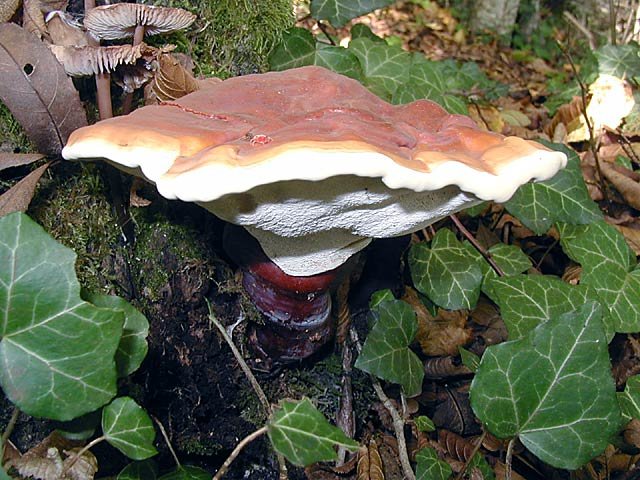
Lacquered polypore, or lacquered Ganoderma (lat.Ganoderma lucidum) is a mushroom of the genus Ganoderma (lat.Ganoderma) of the Ganoderma family (lat.Ganodermataceae).
Lacquered polypores are found in almost all countries of the world at the base of weakened and dying trees, as well as on dead deciduous wood, very rarely on coniferous wood. Occasionally, varnished tinder fungus is found on living trees, but more often fruiting bodies are found on stumps, not far from the soil surface. Sometimes basidiomas grown on tree roots buried in the ground can be found directly on the soil. From July to late autumn.
The cap is 3-8x10-25x2-3 cm, reniform or almost ovoid, flat, very dense and woody. The skin is smooth, shiny, uneven, wavy, divided into many concentric growth rings of different shades. The color of the cap varies from reddish to brown-violet, or (sometimes) black with a yellowish tinge and clearly visible growth rings.
The leg is 5-25 cm in height, 1-3 cm in ∅, lateral, long, cylindrical, uneven and very dense. The pores are small and rounded, 4-5 per 1 mm². The tubules are short, ocher. The spore powder is brown.
The pulp is ocher-colored, very tough, odorless and tasteless. The pulp is spongy at first, then woody. The pores are whitish at first, turn yellow and brown with age.
The mushroom is inedible, it is used exclusively for medical purposes.
Distribution Lacquered polypore - saprophyte, wood destroyer (causes white rot). It is found in almost all countries of the world at the base of weakened and dying trees, as well as on dead deciduous wood, very rarely on coniferous wood. Occasionally, varnished tinder fungus is found on living trees, but more often fruiting bodies are found on stumps, not far from the soil surface.Sometimes fruiting bodies grown on tree roots buried in the ground can be found directly on the soil. During growth, the mushroom can pick up twigs, leaves and other debris into the cap. In Russia, varnished tinder fungus is widespread mainly in the southern regions, in the Stavropol and Krasnodar territories, in the North Caucasus. In temperate latitudes, it is less common than in the subtropics.
Recently, it has spread widely in Altai, in places of predatory felling.
Season: July to late autumn.
Cultivation The cultivation of Ganoderma lucidum is carried out exclusively for medical purposes. Fruit bodies traditionally serve as raw materials for obtaining biologically active substances, much less often the vegetative mycelium of this fungus. Fruit bodies are obtained using extensive and intensive technologies. The vegetative mycelium of Ganoderma lucidum is obtained by submerged culture.
The Reishi mushroom is highly prized and cultivated in the countries of Southeast Asia.
Application The mushroom Ganoderma lucidum is one of the famous basidiomycetes used for medicinal purposes for more than two thousand years by the peoples of Southeast Asia. Linzhi is mentioned in many ancient Chinese medical books: "Herbalist Shen Nun" (Shen Nun Ben Cao Qin) "Compendium of Medicinal Substances" and others. The monograph (Ben Cao Gan Mu) describes Linzhi as the "top" medicine, which means - the most precious , a heaven-given remedy for disease. The books also described in detail the characteristics, methods of application and therapeutic actions of Linchzhi: “... the smell is not pungent, the taste is slightly bitter, intended to eliminate overflow in the chest, increase the qi (energy) of the heart, nourish the middle part of the body, strengthen memory. Medicines based on Linzhi dilate the coronary artery of the heart, enrich the blood with oxygen, eliminate coronary heart disease (CHD), prevent myocardial infarction, and normalize cardiac activity. It was used for various diseases, including bronchial asthma, neurasthenia, gastritis, and liver diseases.
Intensive studies of Ganoderma lucidum over the past decades have shown that biologically active substances isolated from this fungus have immunomodulatory, antitumor, antiviral, antibiotic, hypolipidemic, hypoglycemic, hepatoprotective, gene-protective, anti-inflammatory, anti-allergenic, cardiac, antioxidant- , respiratory and nervous systems.



